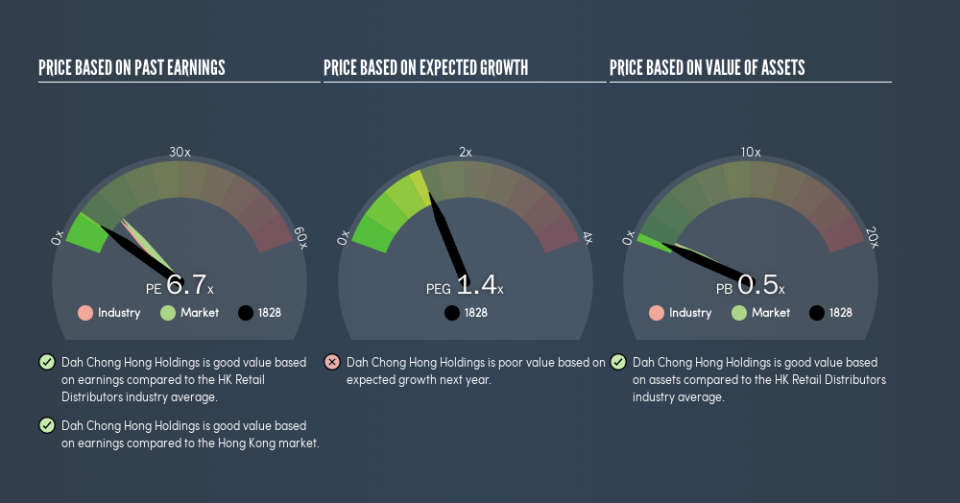Here's How P/E Ratios Can Help Us Understand Dah Chong Hong Holdings Limited (HKG:1828)

This article is written for those who want to get better at using price to earnings ratios (P/E ratios). We'll look at Dah Chong Hong Holdings Limited's (HKG:1828) P/E ratio and reflect on what it tells us about the company's share price. Looking at earnings over the last twelve months, Dah Chong Hong Holdings has a P/E ratio of 6.69. That is equivalent to an earnings yield of about 15%.
Check out our latest analysis for Dah Chong Hong Holdings
How Do You Calculate A P/E Ratio?
The formula for price to earnings is:
Price to Earnings Ratio = Price per Share ÷ Earnings per Share (EPS)
Or for Dah Chong Hong Holdings:
P/E of 6.69 = HK$2.95 ÷ HK$0.44 (Based on the year to December 2018.)
Is A High Price-to-Earnings Ratio Good?
The higher the P/E ratio, the higher the price tag of a business, relative to its trailing earnings. That is not a good or a bad thing per se, but a high P/E does imply buyers are optimistic about the future.
How Growth Rates Impact P/E Ratios
P/E ratios primarily reflect market expectations around earnings growth rates. If earnings are growing quickly, then the 'E' in the equation will increase faster than it would otherwise. Therefore, even if you pay a high multiple of earnings now, that multiple will become lower in the future. Then, a lower P/E should attract more buyers, pushing the share price up.
Dah Chong Hong Holdings maintained roughly steady earnings over the last twelve months. But it has grown its earnings per share by 12% per year over the last three years. And it has shrunk its earnings per share by 2.2% per year over the last five years. So it would be surprising to see a high P/E.
Does Dah Chong Hong Holdings Have A Relatively High Or Low P/E For Its Industry?
We can get an indication of market expectations by looking at the P/E ratio. We can see in the image below that the average P/E (11.3) for companies in the retail distributors industry is higher than Dah Chong Hong Holdings's P/E.
Its relatively low P/E ratio indicates that Dah Chong Hong Holdings shareholders think it will struggle to do as well as other companies in its industry classification. Many investors like to buy stocks when the market is pessimistic about their prospects. If you consider the stock interesting, further research is recommended. For example, I often monitor director buying and selling.
A Limitation: P/E Ratios Ignore Debt and Cash In The Bank
Don't forget that the P/E ratio considers market capitalization. So it won't reflect the advantage of cash, or disadvantage of debt. Theoretically, a business can improve its earnings (and produce a lower P/E in the future) by investing in growth. That means taking on debt (or spending its cash).
Spending on growth might be good or bad a few years later, but the point is that the P/E ratio does not account for the option (or lack thereof).
Dah Chong Hong Holdings's Balance Sheet
Dah Chong Hong Holdings has net debt worth a very significant 109% of its market capitalization. This is a relatively high level of debt, so the stock probably deserves a relatively low P/E ratio. Keep that in mind when comparing it to other companies.
The Bottom Line On Dah Chong Hong Holdings's P/E Ratio
Dah Chong Hong Holdings's P/E is 6.7 which is below average (12.1) in the HK market. It's good to see EPS growth in the last 12 months, but the debt on the balance sheet might be muting expectations.
Investors should be looking to buy stocks that the market is wrong about. As value investor Benjamin Graham famously said, 'In the short run, the market is a voting machine but in the long run, it is a weighing machine.' So this free report on the analyst consensus forecasts could help you make a master move on this stock.
Of course, you might find a fantastic investment by looking at a few good candidates. So take a peek at this free list of companies with modest (or no) debt, trading on a P/E below 20.
We aim to bring you long-term focused research analysis driven by fundamental data. Note that our analysis may not factor in the latest price-sensitive company announcements or qualitative material.
If you spot an error that warrants correction, please contact the editor at editorial-team@simplywallst.com. This article by Simply Wall St is general in nature. It does not constitute a recommendation to buy or sell any stock, and does not take account of your objectives, or your financial situation. Simply Wall St has no position in the stocks mentioned. Thank you for reading.


